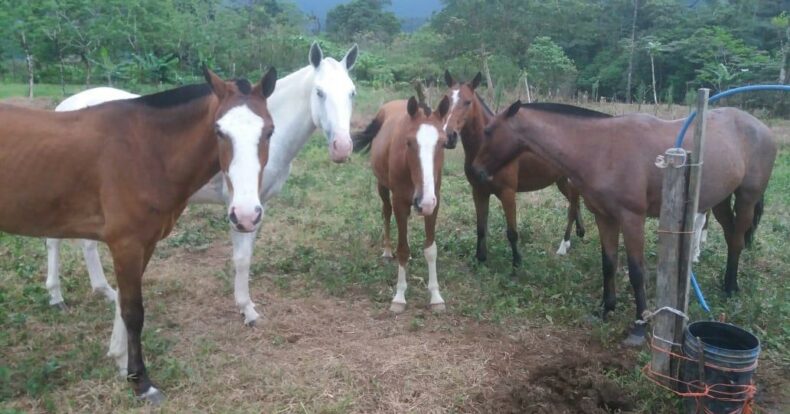The Costa Rican Horse

Since I was a child, I have been passionate about Costa Rican horses. That is why I decided to dedicate myself to them and currently I work full-time with these beautiful animals, mainly for tourism. Here are some interesting facts about Costa Rican horses:
Characteristics
Size: Medium line type.
Weight: 400 kilograms approximately.
Height: 156 centimeters for males and 152 centimeters for females.
Origin: originary from Costa Rica.
Coat: Delicate mane on neck and tail. Delicate skin with short hair accepted in any color except pinto with closed spots. Overo and chorreado are accepted if they come from registered parents.
Suitable for: Saddle horse, ideal for touring.
Space: They require a large stable, horses like exercise in the open air; the more land you can give them the better, 500 square meters is not a bad figure.
History
A distant descendant of the Berber through short and light horses, brought to the country during the Conquest. Thin skin, short hair, delicate mane on neck and tail. Although traces of the primitive horse have been found through fossils discovered in North and South America, the origin of our horse, like other American breeds, is based on the mares brought by the Spaniards after the discovery of America, when the horse returned to this continent.
Description
Straight or slightly convex profile; brilliant and extremely elegant gaits, with elevated movements, excellent action and great energy. Head of medium length, broad at the base with well developed jaws tapering towards the muzzle, medium sized ears, well placed, agile and delicate; well defined orbital arches and large eyes, separated, very expressive and low-placed. Arched neck of medium length and flexible, broad at the base with excellent insertion to the head and trunk. Fine and very high withers. Well developed trunk of medium size, ribs and broad flank in harmony with the dorsal line; muscular and deep chest. Tail with medium set on, in extended and airy action. Legs well plumbed and of medium length, hooves in proportion to the body, hard, rounded and well positioned, without deviations.
Care
Special care should be taken in the health of its legs and in the adequate balance of its diet.
Temperament
Docile.
Morphological characteristics
- Head of medium length, broad at the base, with well-developed jaws tapering towards the muzzle, medium sized ears, well placed, agile and fine; straight profile (not slightly curved or slightly convex as accepted at the beginning), broad forehead, well defined orbital arches, large eyes, wide apart, very expressive and set low. Nostrils well open in action; small and tucked up flews.
Arched neck of medium length and flexible, broad at the base and tapering towards the head forming a sharp arch in the throat and in the topline; with excellent insertion to the head and trunk.
Withers thin and not very high. - Well developed trunk, of medium size, with broad ribs and flank in harmony with the dorsal line; muscular and deep chest, proportionate to the haunch; back with good slope and long, slightly saddled back, strong, short, well attached to the withers; short and strong loin, well attached to the back and haunch with which it must maintain perfect overall harmony; deep ventral line, with greater amplitude in females.
- Wide, long and well developed, slightly rounded haunch. Tail with medium set on, in extended and airy action. Legs well plumb and of medium length, hooves in proportion to the body, hard, rounded and well placed, without deviations.
- Forequarters; arms and elbows with good bone and muscle development; forearms long and strong, with good muscle and bone development; knees well prominent and flat; medium to long shanks, strong bone, prominent and separated tendons, dry and strong giblets; medium long pasterns, oblique, strong, sharp and flexible.
- Hind limbs; long and well muscled thigh, strong, firm and muscled leg, with good angulation, wide, strong, dry and parallel hocks, neither too open nor too closed, strong and dry fetlocks, medium long, oblique, strong, sharp and flexible pasterns that allow a powerful thrust and elevation of the hind legs in the advance, which in full movement can be appreciated because they manage to crush the footprint of the forelegs. Likewise, the forelimbs have good muscular development and bone strength, with prominent tendons and oblique, sharp and flexible pasterns, which allow a natural elevation that distinguishes.
- Delicate mane on neck and tail. Delicate skin with short hair.
Color: Any coat except the pinto of closed spots. Overo and chorreado are accepted if they come from registered parents. - In terms of height, a desirable range is established which does not exclude individuals (pure, purified or foundation) that may be outside the range, depending on the valuation of their other valuable characteristics.
- Minimum height at withers: Males 148 cm. (58.5″), Females 146 cm. (57.50″) minimum.
Maximum height at withers: Males 156 cm (61.50″), Females 152 cm (60.00″) maximum. - They have the ability to see both day and night.
- Consume approximately 1 kg of concentrated feed with vitamins and minerals.
They are capable of working 15 hours a day without getting exhausted.
Author: David Quesada
[email protected]
Navigate articles





